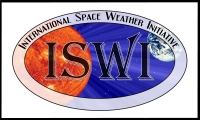Principles of the Instrument Program
The lead scientist or principle investigator funded by his/her country provides instrumentation (or fabrication plans) and data distribution
The host country provides the workforce, facilities, and operational support typically at a local university.
Host scientists become part of science team
All data and data analysis activity are shared
All scientists participate in publications and scientific meetings where possible
New instrument arrays are welcome. To propose new instrument array, please contact Dr. Nat Gopalswamy, e-mail: nat.gopalswamy[at]nasa.gov
-
- Atmospheric Electric Field Network in South America (AFINSA)
Lead Scientist: Dr. Jean-Pierre Raulin (Universidade Presbiteriana Mackenzie) Brazil
Objective: To obtain a daily variation curve of the fair weather Atmospheric Electric Field (AEF) (standard curve) based on means on different time scales, such as monthly, seasonal and annual. - African Meridian B-field Education and Research (AMBER)
Lead Scientists: Dr. Endawoke Yizengaw (The Aerospace Corporation) and Dr. Mark Moldwin (University of Michigan) United States
Objective: Understand low latitude electrodynamics, ULF pulsations, effect of Pc5 ULF on MeV electron population in inner radiation belts - African Dual Frequency GPS Network (AMMA)
Lead Scientist: Dr. Olivier Bock (IGN) France
Objective: To increase the number of real-time dual-frequency GPS stations worldwide for the study of ionospheric variability, response of the ionospheric total electron content (TEC) during geomagnetic storms over the African sector. - Atmospheric Weather Education System for Observation and Modeling of Effects (AWESOME) and SID (Sudden Ionospheric Disturbance Monitor)
Lead Scientist: Dr. Morris Cohen (Georgia Tech), Dr. Umran S. Inan (Stanford), and
Ms. Deborah Scherrer (Stanford) US
Objective: Lightning, electron precipitation, sprites and elves, terrestrial gamma ray flashes, whistlers, geomagnetic storms, radio atmospherics.
(read more) - Boston University All-Sky Imaging Network (BU_ASI)
Lead Scientist: Dr. Michael Mendillo and Dr. Carlos Martinis (Boston Uni) United States
Objective: The BU all-sky imager network has been built to study magnetically conjugate processes in the thermosphere-ionosphere from low latitudes to sub-auroral latitudes. - Compound Astronomical Low-cost Low-frequency Instrument for Spectroscopy and Transportable Observatory (CALLISTO)
Lead Scientist: Arnold Otto Benz, Christian Andreas Monstein (IRSOL) and André Csillaghy (FHNW)
Switzerland
Objective: Study the magnetic activity of a wide range of astrophysical objects with emphasis on the Sun and cool stars - Continuous H-alpha Imaging Network (CHAIN)
Lead Scientist: Kiyoshi Ichimoto and Dr. Satoru UeNo (Kyoto U)
Japan
Objective: Solar activity, flares, filaments, filament eruptions - Coherent Ionospheric Doppler Receivers (CIDR)
Lead Scientist: Prof. Ayman Mahrous (Helwan University, Egypt) and Dr. Trevor W. Garner(U Tex) United States
Objective: To tomographically reconstruct the ionosphere and to provide input to Data Assimilation models - Global Ionosphere Flare Detection System (GIFDS)
Lead Scientist: Dr. Daniela Banyś (German Aerospace Center) Germany
Objective: To issue warnings for mitigating space weather impact on sensitive technologies - Global Muon Detector Network (GMDN)
Lead Scientist: Chihiro Kato (Shinshu U) Japan
Objective: To identify the precursory decrease of cosmic ray intensity that takes place more than one day prior to the Earth-arrival of shock driven by an interplanetary coronal mass ejection - Low-latitude Ionosphere Sensor Network (LISN)
Lead Scientist: Dr. Cesar Valladeres (University of Texas Dallas) United States
Objective: To monitor and specify the conditions of the equatorial and low-latitude ionosphere over South America. - Magnetic Data Acquisition System (MAGDAS)
Lead Scientist: Dr. Kiyohumi Yumoto and Dr. Akimasa Yoshikawa (Kyushu U) Japan
Objective: Study of dynamics of geospace plasma changes during magnetic storms and auroral substorms, the electromagnetic response of iono-magnetosphere to various solar wind changes, and the penetration and propagation mechanisms of DP2-ULF range disturbances - Optical Mesosphere Thermosphere Imager (OMTIs)
Lead Scientist: Dr. Kazuo Shiokawa (Nagoya U) Japan
Objective: Dynamics of the upper atmosphere through nocturnal airglow emissions - Remote Equatorial Nighttime Observatory for Ionospheric Regions (RENOIR)
Lead Scientist: Dr. Jonathan J. Makela (U Illinois) United States
Objective: Study the equatorial/low-latitude ionosphere/thermosphere system, its response to storms, and the irregularities that can be present on a daily basis. - Realistic Ionosphere (RION)
Lead Scientists: Dr. Bodo Reinisch and Dr. Ivan Galkin (U of Massachusetts Lowell)
United States
Objective: To provide accurate and prompt nowcast of the 3D global plasma density distribution in the subpeak ionosphere. - South America Very Low frequency Network (SAVNET)
Lead Scientist: Dr. Jean-Pierre Raulin (U Presbiteriana) Brazil
Objective: Study of the SAMA region at low ionospheric altitudes and its structure and dynamics during geomagnetic perturbations - Scintillation Network Decision Aid (SCINDA)
Lead Scientist: Dr. Keith Groves (Boston College) United States
Objective: Study equatorial ionospheric disturbances to aid in the specification and prediction of communications degradation due to ionospheric scintillation in the earth’s equatorial region - Space Environment Viewing and Analysis Network (SEVAN)
Lead Scientist: Dr. Ashot Chilingarian (Aragats) Armenia
Objective: To improve short and long-term forecasts of dangerous consequences of space storms - Solar Flares detected by Ionospheric Effects (SOFIE)
Lead Scientists: Dr. Norbert Jakowski and Alexander Kasten (German Aerospace Center (DLR)) Germany
Objective: To detect solar radio bursts (solar flares) by measuring continuously the intensity of VLF radio signals considering ionospheric propagation effects on radio waves
- Atmospheric Electric Field Network in South America (AFINSA)
